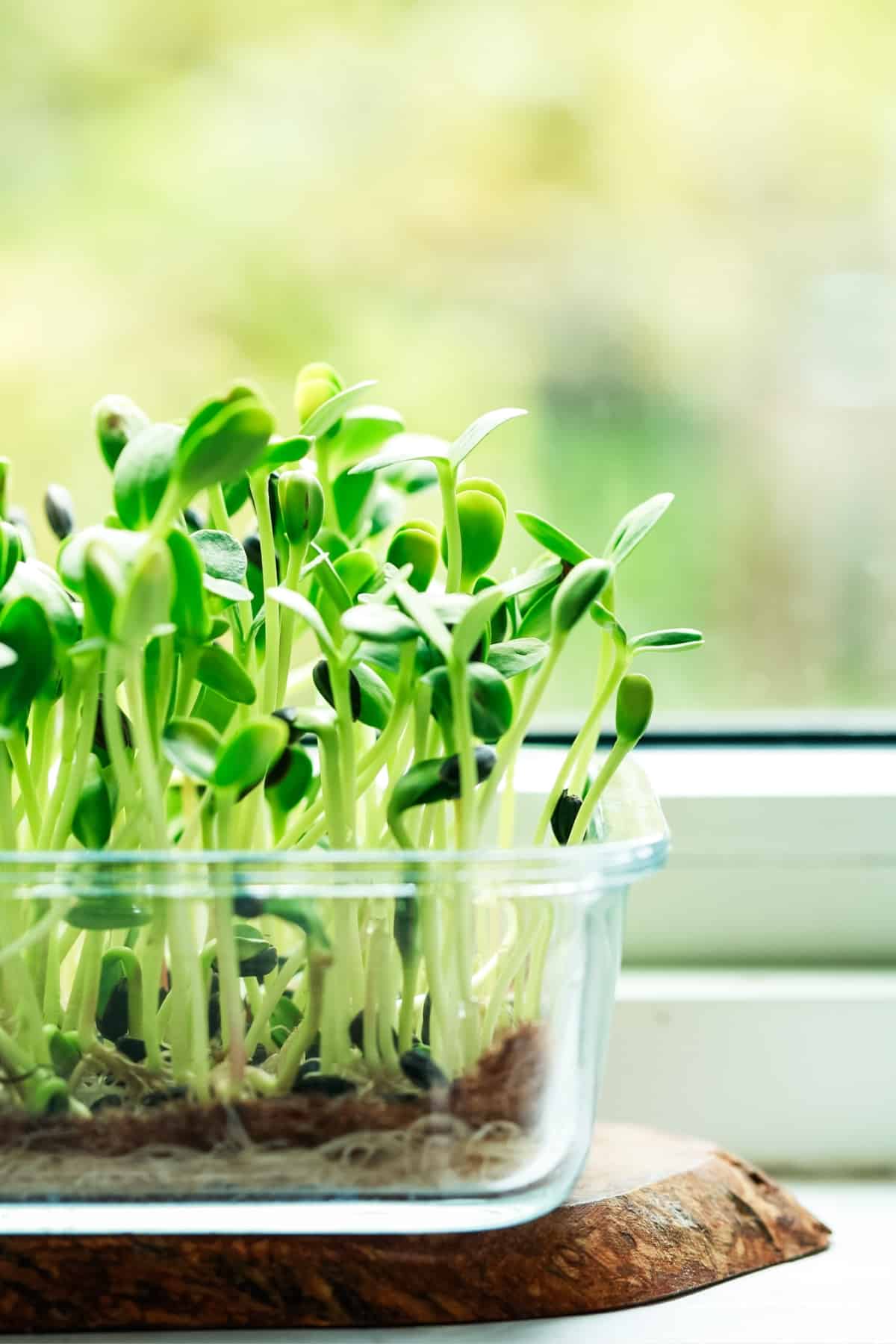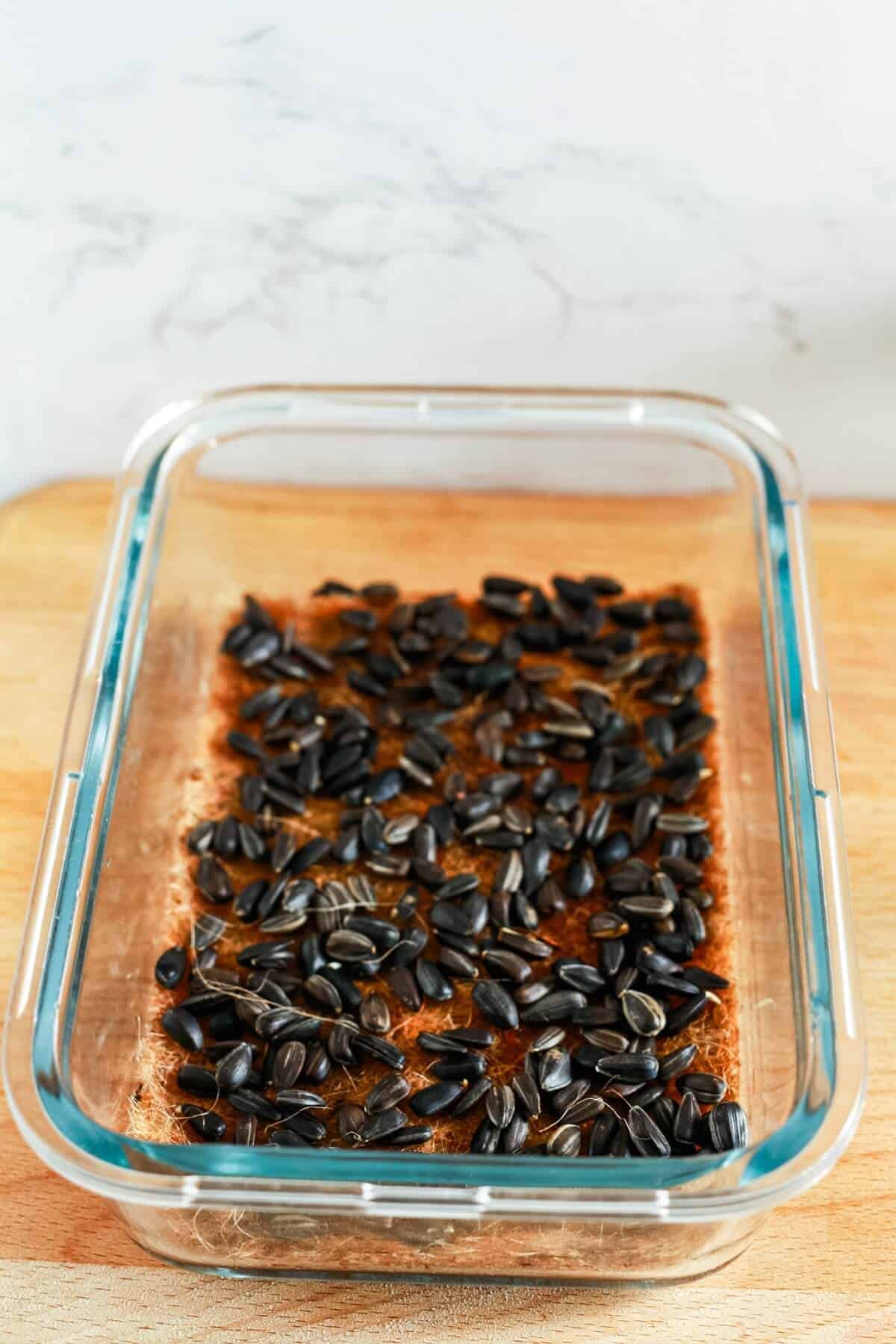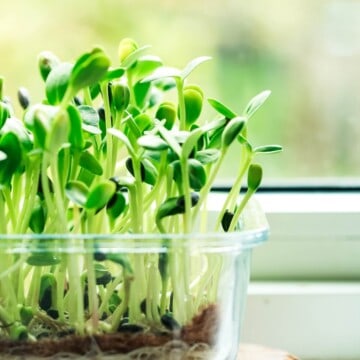Are you curious about how to grow sunflower microgreens at home? Let’s dive into the world of growing sunflower microgreens (a complete guide without soil) so that you can start growing your own.
Sunflower microgreens are so fun to grow! And you can harvest them in about 10-14 days.
Add them to salads, sandwiches, smoothies, sushi, rice paper rolls and as a garnish to many savoury dishes.

This simple guide provides answers to some of the most often-asked questions about growing sunflower microgreens, from selecting the right seeds, the type of container to use, and my step-by-step process for growing them at home without soil.
Sprouting Series
Are you curious about sprouting? If so, then do check out my sprouting series on the blog here to get more familiar with it all.
My other current sprouting recipes include: How to grow broccoli sprouts, how to sprout quinoa, sunflower sprouts, sunflower microgreens, sprouting buckwheat, how to sprout chickpeas, sprouting adzuki beans and how to sprout lentils.
I love growing sprouts and microgreens regularly in my kitchen at home, so I thought it might be nice to share my growing tips with you.
Hopefully, you'll love growing them as much as I do! 😃
It’s easily one of my favourite things to do in the kitchen and takes very little time each day, so they're totally worth the effort.
Jump to:
- Sprouting Series
- What are sunflower microgreens?
- What do they taste like?
- How long do they take to grow?
- Are they easy to grow?
- Buying the right sunflower seeds for microgreens
- Can I grow them without soil?
- Why grow without soil?
- What can I use instead of soil?
- What container can I grow them in?
- Seed planting density
- Step by Step Instructions (with images)
- How do I prepare sunflower microgreens?
- Storage
- TIP
- How do you get the hulls off?
- How to avoid floppy sunflower shoots
- Do I have to grow them in the dark?
- Common problems
- FAQ
- Related
- 📖 Recipe
- Food safety
- 💬 Comments
What are sunflower microgreens?
Sunflower microgreens (also known as sunflower shoots, sunflower greens and sunnies) are the green shoots of sunflower plants that have grown past sprouting to the next stage. They’re often harvested at about 6-8 inches tall.
Plant growing stages:
🌱 Seeds -> Sprouts -> Microgreens -> Baby leaf greens -> 🌻 Fully mature plants
What do they taste like?
Sunflower microgreens have a crisp, slightly nutty, naturally fresh, sweet flavour and are delicious served in salads, wraps, rice paper rolls and soups.
How long do they take to grow?
Sunflower shoots take 10-14 days to grow, depending on their environment. They naturally grow faster in warmer weather.
Are they easy to grow?
They're easy and rewarding to grow, especially growing without soil.
The seeds and shoots are pretty large compared to the smaller ones like broccoli and alfalfa seeds, so you get a good amount of greens for your efforts.

Buying the right sunflower seeds for microgreens
I find that the best seeds to buy are organic black sunflower seeds (black oil sunflower seeds) produced specifically for growing microgreens.
If you can’t find the right seeds in your local high street stores, search online at Whole Foods stores and specialist microgreens instead.
I don’t recommend buying sunflower seeds that are packaged for feeding birds and wildlife, as these can be treated differently than those produced for human consumption.
Can I grow them without soil?
Yes, you can grow sunflower microgreens without soil. I love to use a microgreen growing mat instead. You can find these online.
Some people like to grow them in coconut coir. It's down to your own personal preference.
Why grow without soil?
Soil is heavy to lug about and messy in our small kitchen so I prefer not to use soil.
I recommend grow them both with and without soil to find out what suits you best.
What can I use instead of soil?
> Microgreen growing mats
I love these! They're my absolute favourite way to grow micro's. You can also use them to grow smaller microgreens like alfalfa, clover and broccoli etc.
Growing mats come in various materials, including hemp and jute, which can also be compostable. Check individual packets for confirmation.
All you need to do is cut a growing sheet to size and water it before adding your seeds.
Spread the seeds evenly across the growing sheet and spray daily to keep them moist and prevent them from drying out.
> Coconut Coir
Unlike soil, it's much lighter to carry around, which is a HUGE plus. Coconut coir expands when watered and makes a fabulous soil alternative.
Water the coir well before adding your pre-soaked seeds, but don’t oversoak. Lightly cover the seeds with a little more coir and keep them moist by spraying every 8-12 hours so they don't dry out.
Some people like to grow sunflower microgreens in a 10x20 growing tray with no growing medium at all, just by watering. I haven't been successful growing them this way, hence the growing mats.
What container can I grow them in?
I recommend starting with a seed growing tray or a ceramic/glass dish to begin with. Something that's a couple of inches deep.
I use a 6x8-inch glass dish, 2 inches deep. Works great for 1 person.
The 10x20-inch shallow seed trays are really popular. I have a green one with a white inner layer (you can find them online) which does a great job.
Do look for seed trays with two layers: an inner layer with holes to drain excess water and help with airflow, plus an outer tray without holes to hold it all in.
Seed planting density
You often find seed density instructions on the seed packets themselves. However, for my sunflower seeds, I use this seed density chart Microgreen Seeding Density Calculator - JSCalc.io
Step by Step Instructions (with images)

Step 1. Add sunflower seeds to a jar and soak in water for 8-12 hours. This is the only time your seeds should sit in water.

Step 2. Rinse the seeds well and drain them using a strainer. Repeat every 8-12 hours until they start to germinate.

Step 3. Add seeds to a growing mat and tray.

Step 4. Cover the seeds to block out the light while they start to grow. Adding some weight will help them grow nice and strong.

Step 5. Keep seeds moist by watering twice daily. I like to mist the seeds with a light spray of water every morning and evening to prevent them from drying out.

Step 6. Expose to sunlight after a few days, so they turn green.

Step 7. Water a little, twice each day as needed, being careful to drain any excess water out.

Step 8. Harvest sunflower shoots when ready, day's 10-14.
How do I prepare sunflower microgreens?
Snip with scissors just above the mat, at the base of the shoots, once they’ve grown to the size you want. Rinse with a colander and leave to dry on paper towel for a few minutes before use.
Once the stems have been cut, they won’t regrow.
Storage
Store sunflower microgreens in a lidded container in the fridge, on a piece of kitchen paper. They’re best used within five days. Give them a quick rinse before use.
TIP
You’ll need to keep your sunflower seeds moist but not too wet, otherwise they’ll develop mould. If this does happen, discard them and start again.

How do you get the hulls off?
As your sunflower microgreens begin to grow, some of their black outer shells will fall off. These outer casings are tough and shouldn’t be eaten.
If you brush your hand lightly accross the top of the greens daily, most of the hulls should have fallen off before harvesting. 😀
How to avoid floppy sunflower shoots
If you find that your sunflower shoots grow floppy, here are a couple of things you can do to help:
> Apply some weight. Another thing you can do is to place some weight on them while in the initial stages of growth.
After watering the seeds, place an inverted lid over them and add something heavy like a tin can. This will push down on the seeds and help them to grow nice and strong.
Once the shoots are an inch or more tall, remove the cover/weight and place somewhere bright to continue growing.
> Are they getting enough light? Sunflowers are attracted to the sunlight, which helps them grow nice and strong. So, try to place them somewhere bright or near direct sunlight. I place mine on a windowsill.
If that’s tricky, then you might consider buying a set of grow lights to help.
Do I have to grow them in the dark?
It’s popular to keep them in the dark during the first few days, but it’s not essential.
Try growing them both with and without a covering to see how they respond. There's no hard and fast rule, as experiences do vary.

Common problems
Here are some common problems to be aware of that may be helpful along the way.
- Poor germination: May happen with older or poor quality seeds, or if the seeds aren’t soaked for long enough.
- Uneven growth: Quite common and can be helped with more consistent exposure to light and watering.
- Leggy greens: This sometimes happens if the seeds are spaced too closely together, and the greens aren’t exposed to enough light.
- Overcrowding: Planting too many seeds closely together in the tray.
- Mould and fungus: May be caused by overwatering, poor ventilation and overcrowding of seeds.
- Damping off: A fungal disease that can affect young seedlings, causing them to wilt and die. Ensuring everything is clean, that there is sufficient air circulation and avoiding overwatering can help.
FAQ
Sunflower microgreens are filled with plant-based protein, fibre, vitamins, minerals and antioxidants (source).
Sunflower microgreens are edible and can be enjoyed raw. However, the UK Food Standards Agency recommends people in vulnerable groups always cook any sprouts until steaming hot all the way through before eating them.
They’re commonly eaten in salads, wraps, smoothies, sandwiches and as a garnish for their mild nutty, sweet flavour and crisp texture.
In this guide, we’ve explored how to grow sunflower microgreens without soil. I'd love to know how you get on if you decide to give them a try. Feel free to comment below to let me know how it went. 🙂 Thank you!
Related
Looking for other recipes like this? Try these:
📖 Recipe

Sunflower Microgreens (Complete Guide without Soil)
Equipment
- Glass jar with a lid for soaking seeds
- 6x8-inch Growing tray or dish plus lid
- Growing mat cut to size
- Spray bottle
- weight, such as a tin can
Ingredients
- 24 g Black sunflower seeds
Instructions
- Soak sunflower seeds. Add sunflower seeds to a jar and top with plenty of water. Allow them to soak for 8-12 hours or overnight. This is the only time the seeds should sit in water.
- Rinse and drain. Rinse and drain the seeds well using a strainer every 8-12 hours (twice daily) until first signs of germination when you can see tiny little shoots appear.
- Add seeds to a growing tray. Wet the growing mat and squeeze excess water out. Place inside a tray or dish then spread the seeds out evenly over the top.
- Cover. Cover the tray with an inverted lid then add something heavy on top to weigh them down for the first few days. I like to use a tin. For larger trays use more than one tin or maybe a brick.
- Keep seeds moist. Mist the sunflower seeds lightly with water twice each day (morning and evening) to keep them moist, being careful not to over wet.
- Expose to sunlight. Once the sprouts have grown to about an inch tall, remove the lid. Place the tray somewhere bright so they can grow tall and start to green.
- Water twice daily. Check the greens daily, morning and evening, and water lightly. See notes below.
- Harvest when ready. You can harvest the sunflower microgreens from a few inches tall, typically after 10-14 days. By this time they may be 6-8 inches tall. Using a pair of scissors, snip from above the mat. Rinse and lightly dry on paper towel before use.
Notes
Watering
As the roots begin to grow through the mat, I like to water them by adding a small amount of water to the bottom of the tray. If you leave them for a minute or two, the roots will soak up what they need. Be sure to drain out all the remaining water by tippping it at one end.Storing
Store sunflower microgreens in a suitable container in the fridge for up to 5 days.Growing
For standard 10x20-inch growing trays I use 60g of black sunflower seeds. Check your seed supplier or use an online seed growing calculator for exact details to match the size of your container.Food safety
The UK Food Standards Agency recommends people in vulnerable groups always cook any sprouts until steaming hot all the way through before eating them.
This is because sprouts sometimes contain bacteria, which some people may be susceptible to. Vulnerable groups include the elderly, young children, those with a weakened immune system, and pregnant women.
Never eat sprouts or microgreens that look or smell bad or weird. If you're unsure, then throw them out and start again.
Not all seeds or beans are suitable for sprouting or eating raw. Please be sure to check first.
Check the FSA website for more details.




















Comments
No Comments